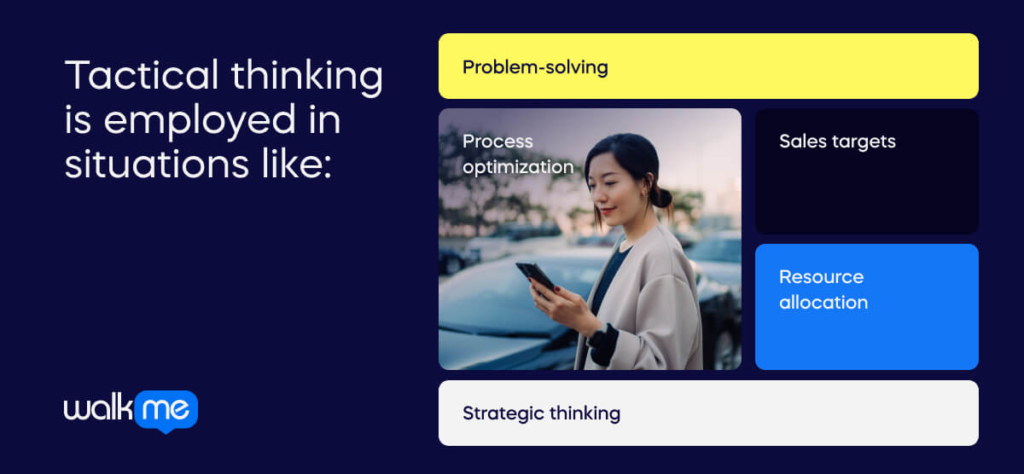The modern business arena is a battlefield where every decision and action, no matter how seemingly insignificant, can mean the difference between victory and defeat.
In this context, two types of thinking are often employed: tactical and strategic.
Tactical thinking centers on immediate actions and problem-solving, employing detailed plans for specific outcomes. It’s the domain of engineers and project managers. Strategic thinking, conversely, focuses on the larger context, predicting future trends and decisions for enduring success.
But what exactly do these terms mean, and how can they be harnessed to give your business the edge it needs?
The recent sea of global change, from COVID-19 to volatile supply chains, has made the need for tactical and strategic business practices more crucial than ever. To adapt to these changes, organizational change is now a constant, and businesses must blend tactical responses to immediate challenges with strategic planning that help ensure the future of work.
While both tactical and strategic thinking have their merits, the key to success in business lies in understanding when to use each approach and how to balance them effectively.
This article explores the power of tactical vs. strategic thinking for business success. We’ll define these terms, identify their role in different business scenarios, and discuss how businesses can leverage them. We’ll also examine their intersection points and provide tips on developing these crucial thinking skills.
What is tactical thinking?
Before we explore the confluence of tactical and strategic thinking, we must comprehend the meaning of each approach and how it applies to business contexts.
Tactical thinking refers to the skill of formulating and executing short-term, detailed plans that address immediate challenges or goals. It involves assessing current circumstances, forecasting potential obstacles, and devising specific actions to achieve intended outcomes.
This strategic thought process is crucial for project managers at the helm of complex projects and initiatives. It gives them better maneuverability and enables their organization to leverage opportunities, manage resources efficiently, and mitigate risks.
Tactical thinking is a dynamic combination of analysis, creativity, decision-making, and problem-solving. It works hand in hand with strategic planning to achieve operational success and maximize returns.
What is strategic thinking?
On the other hand, strategic thinking is an intentional, rational thought process that focuses on analyzing critical factors and variables that contribute to long-term success.
Leaders that employ strategic thinking understand the big picture and anticipate future trends, allowing them to help their companies not just survive but thrive long-term.
It involves seeing the bigger picture, anticipating opportunities and challenges, and utilizing this understanding to guide the organization. Strategic thinkers question if they’re doing the right things and evaluate specific requirements. They understand how industries and the broader economy function and opt for long-term thinking over short-sighted approaches.
This ability to challenge conventional thinking and approach fundamental business drivers uniquely makes strategic thinking valuable for business leaders.
Which business scenarios require tactical thinking vs. strategic thinking?
To better understand the unique strengths of each of these commonly used business methodologies, let’s take a closer look at the business situations in which they’re most relevant.
Tactical thinking is essential for successful project management, engineering operations, and programming. It requires an ability to execute plans quickly and think ahead about possible obstacles or shifting dynamics of the environment.
Tactical thinkers must respond nimbly and efficiently to changing circumstances while closely monitoring short-term goals.
Tactical thinking is employed in situations like:

- Problem-solving: When a problem arises, tactical thinking is used to find an immediate solution.
- Process optimization: Identifying ways to make a process more efficient or cost-effective requires tactical thinking.
- Sales targets: Setting and achieving short-term sales targets involves tactical decisions.
- Resource allocation: Deciding how to best use resources in the immediate future is a tactical decision.
- Strategic thinking, on the other hand, is most useful in positions that require a broader view of the business landscape. C-suite executives and department heads often rely on strategic thinking to guide their organization’s strategy and formulate future objectives.
Strategic methodologies are invaluable for any executive, but understanding when to apply strategic thinking versus tactical thinking is key to successful decision-making.
For instance, strategic thinking is required in scenarios like:
- Long-term business planning: Deciding on the direction the company should take over the next five years requires strategic thinking.
- Mergers and acquisitions: Deciding whether to acquire another company or merge with a competitor is a strategic decision that impacts the company’s future.
- Market expansion: When considering entering new markets or launching new products, strategic thinking is needed to assess potential risks and rewards.
- Crisis management: During a crisis, strategic decisions are needed to navigate the company toward recovery and future growth.
How can businesses leverage tactical vs. strategic thinking?
Companies must balance tactical and strategic thinking to survive in dynamic business ecospheres.
The confluence of these approaches ultimately helps steer the ship in the right direction.
These methodologies intertwine as a strategy guides the selection of appropriate tactics, while real-time operational tactics feed into and inform the larger strategy.
A successful business can think strategically about long-term objectives while executing tactically in response to immediate challenges.
For instance, let’s take the case of a retail company. They might use a strategic approach to understand long-term trends in customer buying behavior, using data analytics to identify seasonal patterns or shifts in preferences over time.
This could involve analyzing years of sales data, customer surveys, and market research to identify trends and predict future behavior.
On the other hand, the same company would also need to employ tactical approaches to respond quickly to emerging patterns and anomalies. For instance, if data analytics revealed a sudden spike in demand for a particular product, the company would need to act quickly to capitalize on this trend.
This could involve ramping up production of that product, adjusting marketing strategies to highlight it, or offering promotional deals to boost sales further.
While distinct, these two concepts work hand in hand to drive a company toward its goals.
Strategies set the direction for a company’s journey, and tactics are the steps that enable it to reach its destination. These two elements are inherently linked and mutually dependent for successful execution.
In what business areas do strategic and tactical thinking intersect?

To better understand where strategic and tactical thinking intersects, we can inspect the following areas:
- Alignment of Objectives: Both strategies and tactics are geared towards achieving the overarching goals of an organization. They function in tandem to drive success.
- Planning Processes: Both strategic and tactical planning involve making decisions and charting actions. While strategic planning zeroes in on long-term objectives, tactical planning delineates the steps required to meet these objectives.
- Allocation of Resources: The distribution of resources is a critical aspect of both strategies and tactics. Strategic decisions outline the overall resource distribution for a business unit. In contrast, tactical decisions allocate these resources at a more granular level, such as for individual projects.
- Performance Assessment: Measurement and evaluation are integral to strategic and tactical approaches to gauge effectiveness. This could be through key performance indicators (KPIs) or other metrics.
- Flexibility: Both strategies and tactics should be adaptable and responsive to shifts in the business landscape. If market conditions evolve, the strategy and tactics may need to be modified accordingly.
How to develop strategic and tactical thinking

As we know, mastering strategic and tactical thinking is key for handling business-critical situations. These skills enable long-term visioning and short-term operational focus, ensuring decisions align with prospective goals. Here’s a guide to developing these vital skills.
- Strategic Thinking:
Define the vision: Start by understanding your organization’s vision and mission. This will give you a clear sense of the direction in which the company is headed.
Analyze the environment: Use tools like SWOT (Strengths, Weaknesses, Opportunities, Threats) and PESTEL (Political, Economic, Social, Technological, Environmental, Legal) to analyze both the internal and external environment of your business.
Set long-term objectives: Based on your vision and environmental analysis, set goals that you would like to achieve in the long term.
Develop a strategic plan: Create a roadmap to achieve these goals. This should include key strategies and initiatives that will help you get there.
Measure and adjust: Regularly monitor your progress towards these goals and make necessary adjustments to your strategies.
2. Tactical Thinking:
Understand the strategy: Before you can think tactically, you need a deep understanding of the strategy you’re working to support.
Set short-term goals: These should align with your long-term strategic objectives and be specific, measurable, achievable, relevant, and time-bound (SMART).
Plan actions: Determine the specific steps that will allow you to achieve your short-term goals. This might involve creating project plans, assigning tasks, and setting deadlines.
Allocate resources: Determine what resources (time, personnel, money, etc.) will be needed to carry out your planned actions and ensure they’re allocated appropriately.
Monitor progress and adjust: As with strategic thinking, it’s important to regularly review your progress toward your tactical goals and change your plans as necessary.
Tactical Vs. Strategic Thinking – What should you choose?
Remember, strategic and tactical thinking should not happen in isolation. They should inform and reinforce each other, creating a dynamic force that drives your business forward.
Despite their interconnection and equal importance in overseeing strategic and tactical thinking, each holds distinctive traits and should not be thoughtlessly exchanged.
In wrapping up, it’s clear that discerning when to utilize strategic or tactical thinking can significantly impact the results of our endeavors. These aren’t interchangeable tools but distinct processes, each with its value.
The key is not to use one instead of the other but to find a balance where both can thrive. Recognizing and capitalizing on their unique strengths at the right moments can be the driving force behind achieving our goals.
